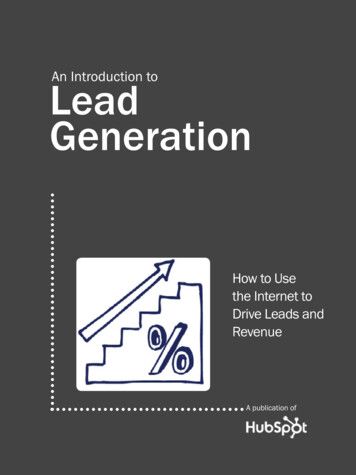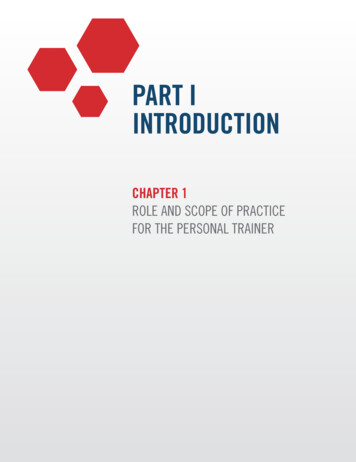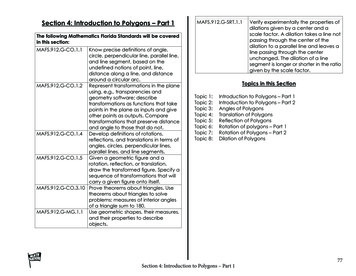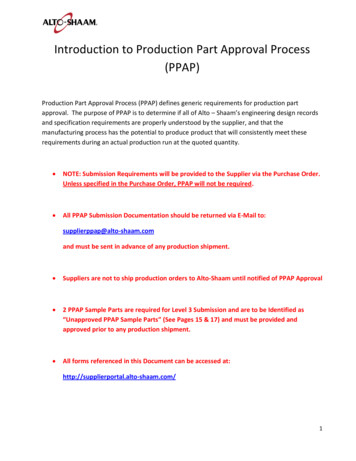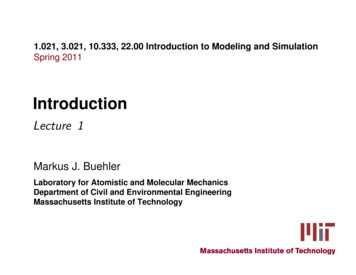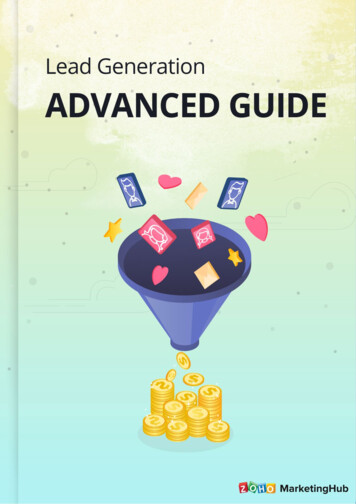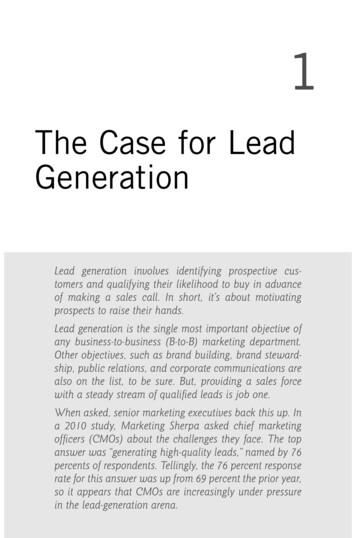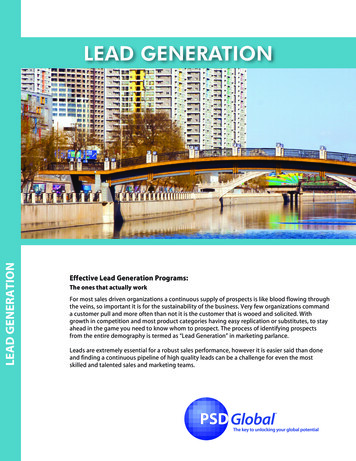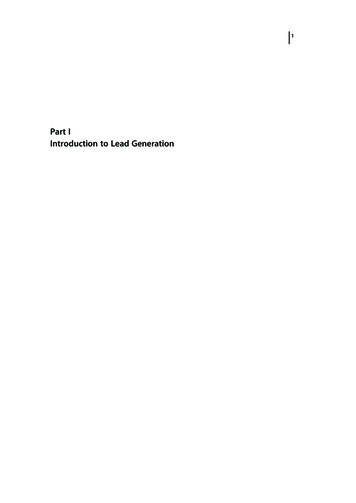
Transcription
1Part IIntroduction to Lead Generation
31Introduction: Learnings from the Past – Characteristics ofSuccessful LeadsMike HannContemporary nodding sages in drug discovery will often be heard to say “Tut,tut, if I wanted to get there, I wouldn’t start from here.” Such comments arebased on their experience (aka insights from hindsight!) where failure of compounds in late lead optimization, preclinical, or clinical work can all too often beassociated with poor chemical and physicochemical properties of the chemicalseries being pursued. It is, of course, one of the basic truisms of science thatwhere we start an optimization process will likely have profound influences onwhere it ends up!If this is true then why does so much of medicinal chemistry, and hence drugdiscovery, still suffer from a lack of awareness of these facts? After all they cansave enormous amounts of time and money that are spent on taking forwardcompounds that fall outside of “drug-like space” until they predictably failed.Is it (1) because people still do not believe in a drug-like space and thus ignorethe fact that compounds invariably get bigger and more lipophilic as lead optimization progresses in the search for potency? Or is it (2) because they believe theywill be exceptional in their skills and that this will allow their project to beequally exceptional and succeed outside of received or accepted wisdom? Or isit (3) that they just cannot find a good starting point that will deliver or, possibly,they have not tried hard enough to find such a starting point? Or is it (4) thatsuch a poor choice of target that finding a small molecule to effectively interactwith it is nigh impossible? All or any of these can be crucial in determining whatcourse a project takes, but one of the biggest confounding issues is that althoughit can be argued (see below) that a drug-like space exists, there are many gooddrugs that fall outside of this drug-like space. Thus that paradoxical saying “theexception that proves the rule” is all too often used to justify continuing. Theeffect of this is to allow reason (2) to be actively beckoning teams away fromsticking to the drug-like space mantra. Only if you have exhaustively tried andfailed to find success in the drug-like space should you feel you have permissionto go beyond it and then you will most definitely need not only all your skills butprobably also a large slice of luck! Note that if we all choose to back the low oddsscenario, that is, (2), all of the time, then we are indeed guaranteeing a poorreturn on investment.Lead Generation: Methods, Strategies, and Case Studies, First Edition. Edited by Jörg Holenz. 2016 Wiley-VCH Verlag GmbH & Co. KGaA. Published 2016 by Wiley-VCH Verlag GmbH & Co. KGaA.
41 Introduction: Learnings from the Past – Characteristics of Successful LeadsSo what is drug-like space? This has somehow erroneously become associatedwith Chris Lipinski’s rule of five (Ro5) that actually refers to the probability thata compound will be orally bioavailable in humans [1]. The Ro5 states that if acompound has more than one violation of the following criteria – greater than 5hydrogen bond donors (defined as the total number of hydrogens directlybonded to O or N), greater than 10 hydrogen bond acceptors (defined by all Nor O atoms in the molecule), a molecular weight greater than 500, an octanol–water partition coefficient LogP greater than 5 – then it will unlikely be orallybioavailable. Thus, the Ro5 only refers to one aspect (the oral adsorption) of theoverall adsorption, distribution, metabolism, excretion, and toxicology (ADMET)profile of a compound. Clearly this, coupled with essential target engagement, iscritical to the likelihood of it being an acceptable and efficacious drug. This conflation of Ro5 with drug space is probably due to the fact that most drug discovery projects do aspire to having oral bioavailability but while this may bedesirable it is not sufficient. To truly define a drug-like space, we need guidanceon parameters such as solubility, permeability, dose, toxicity, metabolism, and soon. Over the past 5–10 years, many analyses of large data sets from pharmacompanies have been published. A selection of the resulting “rules of thumb”1)about the preferred drug-like space are summarized in Table 1.1 . The use ofsuch cutoff-based rules has often been criticized as being too black and whiteand, as a consequence, other more subtle ways of doing data fusion have beenintroduced (e.g., the quantitative estimate of drug-likeness (QED) by Hopkinsand colleagues that uses weighted desirability functions [2]).The prevalence of lipophilicity in these rules indicates how important it is topay particular attention to this property. The term “molecular obesity” wasintroduced as a way to anthropomorphize the impact and danger of too muchlipophilicity in compounds in development by analogy to the dangers of medicalobesity [12]. The causative reasons why there is a tendency to allow lipophilicityto increase were also analyzed in this paper and Table 1.2 lists a number of themore obvious ones.At the end of the day, it is often the required human dose that defines whethera drug is successful. Dosage determinants can be broadly divided into two keycomponents – first, how much drug gets to the site of action and second howtightly does the drug bind to its target thus eliciting the desired effect. This balance between potency and availability is elegantly expressed in the drug efficiency index (DEI) developed by scientists at GSK in Verona [16]. Drugefficiency (DE) itself is defined as the fraction of administered dose that becomesavailable as the biophase concentration. The derived term DEI is then defined asthe affinity pKi (log of affinity constant) added to log10DE. Thus, if the drug efficiency is less than 1%, it contributes a negative number when the logarithm istaken and rapidly detracts from the intrinsic potency of a compound. Another1) If you’ve ever tried using your thumb to measure something, then you will be only too well awarehow imprecise yet somehow reliable and convenient it is as a measure in the absence of somethingmore precise!
Introduction: Learnings from the Past – Characteristics of Successful LeadsTable 1.1 Drug-like space guidance on physchem properties.Drug-like property consideredGuidanceReferenceLipinski/Pfizer Ro5 for OralbioavailabilityViolating 2 or more of MW 500,LogP 5, HBD 5, and HBA 10 resultsin poor oral bioavailabilityMaximize LLE pIC50 logP to reducepromiscuityKeep cLogP 3 and PSA 75 tominimize toxicityKeep cLogP 4 and MW 400 for generally favorable ADMET propertiesOn average larger “small molecules”need more lipophilicity to penetratemembranesFavored space from Property ForecastIndex (PFI) when PFI mChromLogD7.4 number of aromatic rings 6.But note that permeability max inPFI 6–8Keep predicted human efficacious dosageof 250 nM (total drug) and 40 nM(free drug)Compounds with DCS classification of I,IIa, or III are much easier to develop[1]AZ receptor promiscuityPfizer 3/75 rule for toxicityGSK 4/400 rule for general ADMETAZ permeability modelGSK PFI model for general drug-likeproperties (including solubility)Pfizer dosage guidance for reducingtoxicityGSK Developability ClassificationSystem based on permeability, dose,and solubilityDrug-like property reviewsGeneral overviews[3][4][5][6][7][8][9][10,11]useful way of thinking about drug efficiency is in terms of the amount of a dosethat is being wasted; for instance, if a drug has a DE of 0.1%, then it means that99.9% of a dose is never used at the target to elicit the required pharmacology!Low dosage is not only good from the point of helping reduce the costof goods but is also one of the only known predictors for low incidence ofTable 1.2 Reasons for lipophilicity increases in discovery projects.Reason for logP increaseHow to mitigateReferencePotency is most easily attained by lipophilic interactions that arenondirectionalPermeability sweet spot is often foundby indiscriminate use of lipophilicity –particularly for larger moleculesOrganic synthesis favors purification oflipophilic compoundsEnsure maximum potency throughpolar (enthalpic) interactions isachievedUse of LLE to control lipophilicitydriven membrane effects[13]Design synthesis, work-up, and purification schemas that can cope withmore polar molecules[15][14]5
61 Introduction: Learnings from the Past – Characteristics of Successful Leadsidiosyncratic toxicity [17]. Thus, it is generally considered very unlikely thatidiosyncratic drug reactions will occur at a total dose of 10 mg per day.Another perspective on this can be gained from a study by Pfizer scientists onthe survival of CNS active compounds as they progress through the developmentprocess, which suggests that a predicted human efficacious concentration of 250 nM (total drug) and 40 nM (free drug) was a good concentration to aimfor [8]. It is interesting to note that 250 nM of a 500 Da molecule is equivalent to10 mg dissolved in 80 l, (i.e., the approximate size of an average adult), and whilewe are not all water and certainly not homogeneous, it is interesting how thesetwo widely different approaches to gaining insights into a good drug dosage converge on the same number. It is also worth remembering that the median affinityfor small-molecule drugs at their actual target, where known, is around 20 nM,which is again consistent with the sorts of concentrations discussed here [18].So, potency is a good thing but not in isolation of good pharmacokinetic properties. The challenge for medicinal chemistry is to optimize the two in parallel,which can be difficult when potency is easily driven by lipophilic interactions.Furthermore, potency is often the quickest experimental measurement to bereturned to a project team and thus all too often overinfluences the next roundof medicinal chemistry.Another aspect of dose that is often misunderstood is the influence of the solubility of a drug, which is often far too low (especially for lipophilic molecules)to allow sufficient drug to be absorbed in the time that it passes through the GItract. A useful way to represent this is via the developability classification system(DCS) that explores the interplay between permeability, dose, and solubility [9].Poor-solubility compounds (i.e., those with dose/solubility ratios greater than1000) require more liquid than the GI tract has available, meaning that the onlyless soluble compounds that can be sufficiently absorbed are those with veryhigh permeability (this is class IIa in the DCS system). The fact that “brick dust”is a common term in the medicinal chemist’s lexicon is testament to the prevalence of this challenge.Having explored some of the key aspects and challenges of drug-like space(and other chapters go into this in far greater detail), it is time to turn to theissue of lead-likeness. The term lead-like was first used in 1999 by SimonTeague and his colleagues at AZ in a publication entitled “The design ofleadlike combinatorial libraries” [19]. This was an era where combinatorialchemistry was being used to feed high-throughput screens with novel compounds on the premise that ever-increasing numbers of compounds could bescreened. The assumption being that large library synthesis would enablesuch diversity to be assessed that drug discovery could be industrialized andthus increase productivity [20]. The AZ authors were among the first to recognize that the lead optimization journey between a lead compound (i.e., thestarting point) and the final candidate compound invariably involves anincrease in mass. This occurs as potency is built by making new or betterinteractions than were in the lead. They proposed that there is a “great
Introduction: Learnings from the Past – Characteristics of Successful Leadsdeal of precedent to suggest that libraries consisting of molecules with MW100–350 and clogP 1–3.0 are greatly superior to those comprising druglikecompounds.” In the following year, both Hann, Leach, and Harper at GSKand Oprea et al. at AZ published compilations of property differencesbetween historical drugs and what were considered their lead-like startingpoints [21,22]. In the publication by Hann, Leach, and Harper, a theoreticalanalysis of why this increase might occur was also presented based onthe concept of molecular complexity [21]. Thus, less complex compoundsare easier to find because when there are less features in the ligand there areless bad interactions possible that can abrogate binding. The downside is thatless complex starting points will likely need more sensitive assays to detectthem. Soon afterward, the concept of ligand efficiency was proposed byHopkins, Groom, and Alex at Pfizer, which spawned a whole raft of otherindices to help medicinal chemists find the most efficient molecules in termsof mass, logP, polar surface area, and so on [23]. Much has been written andreviewed about the pros and cons of using such metrics or indices [24]. Suffice it to say here that one of the major pros has been the heightened awareness of the importance of good leads and the dangers of property inflation inlead optimization. Another consideration that has recently emerged is theimportance of ensuring that enthalpic interactions are maximized early inlead optimization to reduce the overreliance on entropic binding for potency(often connected with lipophilic interactions) [25]. Also in this review, sevenguidelines for medicinal chemists were suggested to help ensure that appropriate efforts were focussed on finding the balance between many conflictingdemands. Thus, it is vitally important that in optimization, a good lean andefficient lead is not squandered by inappropriate addition of, for example,lipophilicity. These guidelines are repeated here as they give a succinctsummary of the diversity of issues to be considered.1) Consider the chemical tractability (ligandability) of the target, and if itis poor then investigate different mechanisms of
Introduction to Lead Generation 1. 1 Introduction: Learnings from the Past – Characteristics of Successful Leads Mike Hann Contemporary nodding sages in drug discovery will often be heard to say “Tut, tut, if I wanted to get there, I wouldn’tstartfromhere.” Such comments are based on their experience (aka insights from hindsight!) where failure of com- pounds in late lead optimization .
